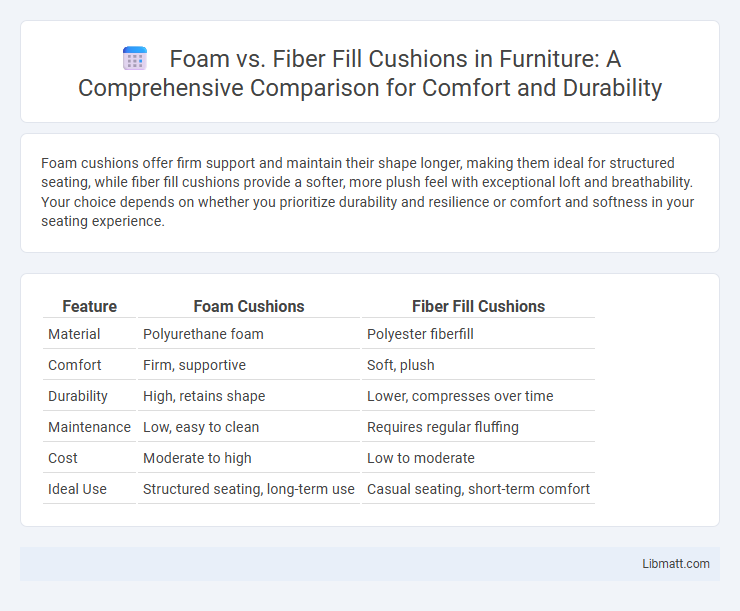Foam cushions offer firm support and maintain their shape longer, making them ideal for structured seating, while fiber fill cushions provide a softer, more plush feel with exceptional loft and breathability. Your choice depends on whether you prioritize durability and resilience or comfort and softness in your seating experience.
Table of Comparison
| Feature | Foam Cushions | Fiber Fill Cushions |
|---|---|---|
| Material | Polyurethane foam | Polyester fiberfill |
| Comfort | Firm, supportive | Soft, plush |
| Durability | High, retains shape | Lower, compresses over time |
| Maintenance | Low, easy to clean | Requires regular fluffing |
| Cost | Moderate to high | Low to moderate |
| Ideal Use | Structured seating, long-term use | Casual seating, short-term comfort |
Introduction to Foam and Fiber Fill Cushions
Foam cushions offer firm support and maintain shape over time due to their dense polyurethane construction, making them ideal for seating durability. Fiber fill cushions provide a softer, plush feel with lightweight polyester fibers that mimic down but require frequent fluffing to retain loft. Understanding these materials helps in selecting cushions that balance comfort, support, and maintenance needs.
Key Differences Between Foam and Fiber Fill
Foam cushions offer firm support and retain their shape longer, making them ideal for structured seating, while fiber fill cushions provide a softer, more plush feel with greater fluffiness but tend to compress over time. Foam is typically denser and more durable, offering better resilience against daily wear, whereas fiber fill is lightweight and easier to adjust or fluff for customized comfort. Your choice depends on whether you prioritize long-lasting support or a cozy, cushioned experience.
Comfort Level: Foam vs Fiber Fill
Foam cushions provide firm support and retain shape longer, making them ideal for those seeking consistent comfort and durability. Fiber fill cushions offer a softer, plusher feel with excellent breathability but tend to compress more quickly over time, requiring frequent fluffing to maintain loft. Choosing between foam and fiber fill depends on the desired balance between firmness, resilience, and initial softness in seating comfort.
Durability and Longevity Comparison
High-density foam cushions offer superior durability and retain their shape longer compared to fiber fill cushions, which tend to flatten and compress over time. Foam cushions provide consistent support and resistance to sagging, making them ideal for heavy use and extended longevity. Fiber fill cushions require frequent fluffing to maintain loft but often need replacement sooner due to faster degradation and loss of structural integrity.
Support and Resilience: Which Performs Better?
Foam cushions provide superior support and resilience due to their ability to retain shape and offer consistent firmness over time, making them ideal for long-term use. Fiber fill cushions excel in softness and immediate comfort but tend to compress and lose support faster, requiring regular fluffing to maintain loft. High-density foam variants outperform fiber fill by resisting wear and maintaining ergonomic support, which is crucial for posture and durability in upholstery.
Maintenance and Care Requirements
Foam cushions require regular spot cleaning and occasional airing out to prevent moisture buildup and odor, while fiber fill cushions need frequent fluffing to maintain their shape and reduce clumping. Both types benefit from using removable, washable covers to extend their lifespan and keep allergens at bay. Your choice impacts the ease of upkeep, with foam offering more structural support and fiber fill giving a softer, more breathable feel.
Cost Comparison: Foam vs Fiber Fill Cushions
Foam cushions generally cost more than fiber fill cushions due to their durability and high-density material, which provides better support and longevity. Fiber fill cushions are typically less expensive upfront but may require more frequent replacement as they tend to compress and lose shape faster. Investing in foam cushions often results in long-term savings despite the higher initial price, making them a cost-effective choice for furniture with heavy use.
Environmental Impact and Sustainability
Foam cushions often rely on petrochemical-based materials, which contribute to higher carbon footprints and longer decomposition times in landfills, whereas fiber fill cushions typically feature natural or recycled fibers that enhance sustainability through biodegradability and reduced resource consumption. Choosing cushions with eco-friendly certifications, such as CertiPUR-US foam or recycled polyester fibers, minimizes environmental impact and supports greener manufacturing practices. You can reduce your ecological footprint by prioritizing cushions made from renewable or recycled materials that balance comfort with sustainable benefits.
Best Applications for Each Cushion Type
Foam cushions provide firm support and maintain shape, making them ideal for seating that requires durability and structure, such as office chairs and modern sofas. Fiber fill cushions offer a softer, more plush feel with excellent breathability, perfect for casual furniture like lounge chairs, decorative pillows, and lightweight outdoor seating. Your choice between foam and fiber fill cushions depends on whether you prioritize long-lasting support or a cozy, cushioned comfort.
Choosing the Right Cushion for Your Needs
Foam cushions offer firm support and durability, making them ideal for individuals seeking long-lasting comfort and structure. Fiber fill cushions provide a softer, more plush feel and are perfect for those prioritizing lightweight and easily fluffed options. Choosing the right cushion depends on whether you prefer resilience and shape retention or softness and flexibility in your seating.
Foam vs Fiber Fill Cushions Infographic

 libmatt.com
libmatt.com